June 13, 2023, 8:35pm ET
Click here to see ISW’s interactive map of the Russian invasion of Ukraine. This map is updated daily alongside the static maps present in this report.
Click here to access ISW’s archive of interactive time-lapse maps of the Russian invasion of Ukraine. These maps complement the static control-of-terrain map that ISW produces daily by showing a dynamic frontline. ISW will update this time-lapse map archive monthly.
Note: The data cutoff for this product was 2:30pm ET on June 13. ISW will cover subsequent reports in the June 14 Russian Offensive Campaign Assessment.
Ukrainian forces continued counteroffensive operations in at least three directions and made further limited territorial gains on June 13. Ukrainian Deputy Defense Minister Hanna Malyar reported that Ukrainian forces advanced by 250 meters northeast of Bakhmut and by 200 meters south of Bakhmut.[1] Malyar also reported that Ukrainian forces advanced 500-1,000m in the past 24 hours around the administrative border between Zaporizhia and Donetsk oblasts, liberating around three square kilometers of territory in the area.[2] Ukrainian General Staff Spokesperson Andriy Kovalev reported that Ukrainian forces have liberated over 100 square kilometers of territory since beginning counteroffensive operations.[3] Wagner financier Yevgeny Prigozhin claimed on June 13 that he assesses that Ukrainian forces have likely liberated more than 100 square kilometers.[4] Russian sources claimed that Ukrainian forces continued ground assaults southwest of Orikhiv and south of Hulyaipole in western Zaporizhia Oblast on the night of June 12 to 13.[5] Russian sources widely reported that the tempo of Ukrainian operations in the Orikhiv area has declined in recent days.[6]Ukrainian Ministry of Defense Environmental Safety Department and Mine Action representative Major Vladyslav Dudar reported on June 13 that Russian forces are regularly destroying small dams in localized areas of southern Ukraine to disrupt Ukrainian counteroffensive operations.[7]
Russian President Vladimir Putin met with 18 prominent Russian milbloggers and war correspondents to discuss the progress of the Russian invasion of Ukraine on June 13.[8] Putin largely met with milbloggers closely associated with the All-Russia State Television and Radio Broadcasting Company and other state-owned outlets, notably excluding milbloggers who have been more critical of Putin’s war effort.[9] Putin addressed several key milblogger concerns relating to the Ukrainian counteroffensive, Russian objectives in Ukraine, Russian mobilization and the possibility of imposing martial law, the formalization of private military companies (PMCs), and hostile incursions into Belgorod Oblast.
Putin discussed the progress of the Ukrainian counteroffensive and signaled that he believes Russia can outlast Western military support for Ukraine. Putin stated that Russian objectives have not fundamentally changed, reiterating boilerplate and false narratives accusing Ukraine and NATO of initiating the war.[10] Putin added that the West can push Ukraine into negotiations with Russia by stopping the supplies of military aid to Ukraine.[11] Putin noted that Ukrainian forces launched a ”massive” counteroffensive on June 4 and noted that Ukrainian forces attacked in southwestern Donetsk and Zaporizhia oblasts, claiming they suffered significant losses. Putin claimed that Ukraine has lost 160 tanks and claimed that 30 precent of Ukraine’s casualties are killed in action, whereas Russian forces have lost only 54 tanks. Putin may be attempting to systematically amplify and misrepresent Ukrainian losses of Western military equipment to portray Ukraine’s counteroffensive as failed and discourage the West from continuing to support Ukraine. Former Russian officer and ardent ultranationalist Igor Girkin observed that Putin’s comments indicate that the Russian Ministry of Defense (MoD) continues to misinform him about the true situation on the battlefield.[12]
Putin indicated that he is unwilling to announce a second wave of mobilization or declare martial law, despite maintaining his maximalist objectives in Ukraine. Putin acknowledged that some Russian “public figures” are discussing the urgent need for mobilization but noted that there “is currently no need today” for mobilization. Putin boasted about Russian contract service recruitment efforts using rhetoric consistent with ISW’s previous assessments that Putin is disinterested in announcing another mobilization wave and is instead prioritizing volunteer recruitment.[13] Putin also downplayed milbloggers’ concern over the Kremlin’s decision to not declare full-scale martial law throughout Russia, stating that Russia needs to expand its law enforcement rather than declare martial law. ISW continues to assess that Putin is a risk-averse actor who is hesitant to upset Russian society by ordering another mobilization wave or establishing martial law throughout Russia, indicating that Putin has not yet decided to fully commit to fighting a total war. Putin’s statements likely aim to reassure his constituencies that he does not intend to expand the “special military operation” further.
Putin aimed to assuage widespread discontent in the Russian information space about limited cross border raids by pro-Ukraine forces into Belgorod Oblast, drone strikes across Russia, and border security in general. Putin stated that Russian forces do not plan to divert forces from other sectors of the frontline in Ukraine to Belgorod and other border oblasts in response to border incursions and drone strikes on Russian territory.[14] Putin stated that Russian leadership is considering creating a buffer zone within Ukraine to prevent Ukrainian forces from reaching Russian territory, but caveated the suggestion by saying that Russian officials will not immediately create a buffer zone and will examine how the situation develops.[15] Russian officials have previously responded to limited tactical activity in Belgorod Oblast and other border oblasts by calling for a Russian offensive to push Ukrainian forces away from the international border with Russia in Kharkiv Oblast.[16] Putin’s comments indicate that the Kremlin does not intend to react to cross-border operations in an effort to preserve forces for combat in Ukraine, despite growing discontent within Russia prompted by the raids. Putin also confirmed that Russian conscripts are serving in Belgorod Oblast and that Colonel General Alexander Lapin commanded conscripts to repel the pro-Ukrainian all-Russian limited raids in Belgorod Oblast. Russian forces are likely deploying conscripts to serve in border oblasts due to a lack of reserves and an unwillingness to transfer forces away from the frontline elsewhere in Ukraine. ISW previously assessed that limited raids and border shelling in Belgorod Oblast have become a notable focal point for criticism against the Russian military leadership, and Putin is likely attempting to address critiques that he has ignored the situation there in order to insulate himself from further criticism.[17]
Putin discussed the importance of formalizing volunteer formations, supporting the Russian MoD’s measures to centralize its control over operations in Ukraine. Putin claimed that all volunteer formations serving in Ukraine must sign military contracts with the Russian MoD to “bring everything in line with common sense, established practice, and the law” and to ensure that individual volunteers can legally receive state social benefits.[18] Putin emphasized that the Russian government cannot provide social guarantees to volunteer structures without signed contracts.[19] Putin’s emphasis on the legality of volunteer formations suggests that Putin may be intending to either assert direct control over or set conditions to ban state assistance to select private military organizations (PMCs) such as the Wagner Group, which are technically illegal under the Russian law.
Putin is likely continuing to publicly engage with, and platform select pro-Kremlin milbloggers to further leverage the community to expand his support among Russian ultranationalists. Putin previously held a closed-door meeting with milbloggers on June 17, 2022, to defuse growing discontent about Russian setbacks in Ukraine, and has occasionally interacted with the pro-Kremlin milblogger community since.[20] ISW previously assessed that the milblogger community rose to prominence likely as a direct result of the Kremlin’s failure to establish an effective social media presence as well as its general failure to prepare the Russian public for a serious and protracted war.[21] The Kremlin has protected Russian milbloggers from criticism and calls for censorship and has rewarded select milbloggers with official positions to co-opt their audience and gain access to their close ties to prominent nationalist and pro-war groups.[22] Putin’s highly publicized meeting with the milbloggers is reflective of the Kremlin’s promotion of this group in the previous year and suggests that Putin intends to further elevate their standing. Putin is likely setting information conditions to prevent potential lines of attack against the Kremlin in the event of Russian failure. Putin may also be increasingly aware that committed pro-war figures are his key constituency as he calls on the Russian public to prepare for a protracted war in Ukraine. The Kremlin is likely aware that key pro-war figures will be crucial to rallying the rest of society to that effort, and Putin’s engagement with these milbloggers may suggest that the Kremlin will increasingly rely on the wider ultranationalist community to maintain support for the war effort.
Russian sources claimed that a Ukrainian missile strike killed Chief of Staff of the 35th Combined Arms Army (Eastern Military District) Major General Sergei Goryachev in Zaporizhia Oblast.[23] ISW has observed other elements of the Eastern Military District including elements of the 58th Combined Arms Army and 5th Combined Arms Army operating in western Zaporizhia Oblast.[24] Goryachev’s reported death in Zaporizhia Oblast could suggest that Russian forces have dedicated elements of the 35th Combined Arms Army to operations in Zaporizhia Oblast and that some Russian senior military command officials continue to operate close to the frontline and remain exposed to accurate Ukrainian strikes.[25]
Russian forces conducted missile and drone strikes across Ukraine on June 13. The Ukrainian General Staff reported that Russian forces launched 16 Kh-101/555 cruise missiles and four Shahed 131/136 drones that targeted infrastructure facilities in Kharkiv Oblast and residential buildings in Kryvyi Rih.[26] The Ukrainian General Staff reported that Ukrainian forces destroyed 11 Kh101/555 missiles and one Shahed drone.[27]
Russian authorities continue to express increasing concern over information related to Russia’s defense industrial base (DIB). The Russian Federal Security Service (FSB) reportedly arrested two defense sector employees for allegedly collaborating with Ukraine and Germany.[28] A Russian milblogger claimed that the FSB arrested an engineer at the end of May who worked in the defense industry and collaborated with the Ukrainian Main Intelligence Directorate (GUR).[29] Russian opposition news outlet SOTA reported that the FSB arrested a former employee of a defense enterprise for allegedly providing information to Germany about the Russian defense industry.[30] ISW has previously reported on Russian authorities arresting individuals with reported access to DIB-related information.[31]
Key Takeaways
- Ukrainian forces continued counteroffensive operations in at least three directions and made further limited territorial gains on June 13.
- Russian President Vladimir Putin met with 18 prominent Russian milbloggers and war correspondents to discuss the progress of the Russian invasion of Ukraine on June 13.
- Putin discussed the progress of the Ukrainian counteroffensive and signaled that he believes Russia can outlast Western military support for Ukraine.
- Putin indicated that he is unwilling to announce a second wave of mobilization or declare martial law, despite maintaining his maximalist objectives in Ukraine.
- Putin aimed to assuage widespread discontent in the Russian information space about limited cross border raids by pro-Ukraine forces into Belgorod Oblast, drone strikes across Russia, and border security in general.
- Putin discussed the importance of formalizing volunteer formations, supporting the Russian MoD’s measures to centralize its control over operations in Ukraine.
- Putin is likely continuing to publicly engage with, and platform select pro-Kremlin milbloggers to further leverage the community to expand his support among Russian ultranationalists.
- Russian sources claimed that a Ukrainian missile strike killed Chief of Staff of the 35th Combined Arms Army (Eastern Military District) Major General Sergei Goryachev in Zaporizhia Oblast.
- Russian forces conducted missile and drone strikes across Ukraine on June 13.
- Russian authorities continue to express increasing concern over information related to Russia’s defense industrial base (DIB).
- Russian forces continued ground attacks on the Kreminna frontline but did not conduct offensive operations on the Kupyansk-Svatove line.
- Ukrainian forces continued to advance on Bakhmut’s northern and southern flanks, while Russian forces launched counterattacks in the vicinity of Bakhmut.
- Russian forces continued offensive operations on the Avdiivka-Donetsk City line and are transferring additional forces from east (left) bank Kherson Oblast to reinforce the direction.
- Russian forces conducted limited ground attacks near the administrative border of Donetsk and Zaporizhia oblasts.
- Russian President Vladimir Putin claimed that the Russian military have recruited 150,000 contract servicemembers as well as over 6,000 volunteers since January 2023.
- Russian occupation officials in east (left) bank Kherson Oblast are reportedly continuing evacuation efforts, although are likely continuing to deny services to some residents in flooded areas.
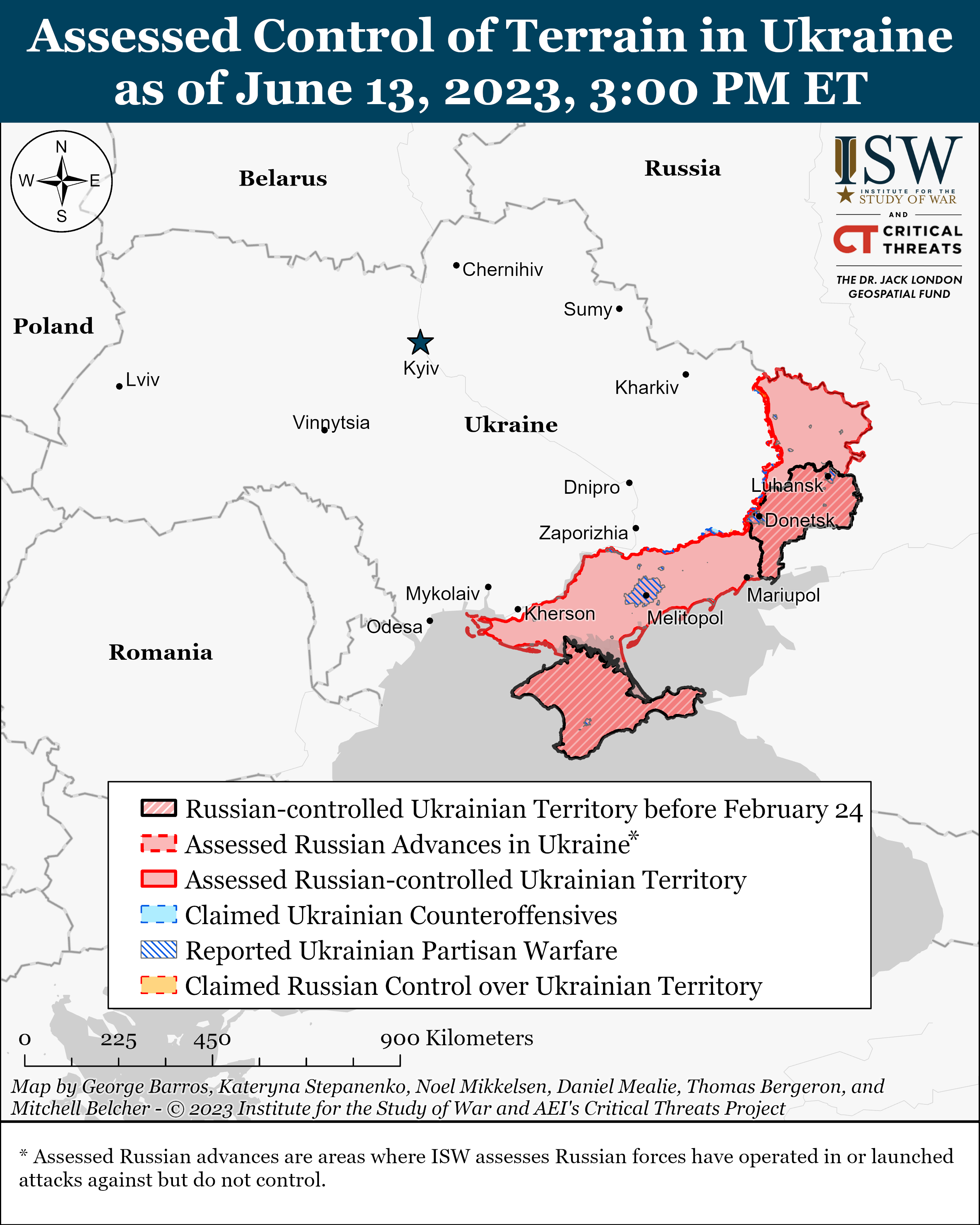
We do not report in detail on Russian war crimes because these activities are well-covered in Western media and do not directly affect the military operations we are assessing and forecasting. We will continue to evaluate and report on the effects of these criminal activities on the Ukrainian military and the Ukrainian population and specifically on combat in Ukrainian urban areas. We utterly condemn these Russian violations of the laws of armed conflict, Geneva Conventions, and humanity even though we do not describe them in these reports.
- Russian Main Effort – Eastern Ukraine (comprised of two subordinate main efforts)
- Russian Subordinate Main Effort #1 – Capture the remainder of Luhansk Oblast and push westward into eastern Kharkiv Oblast and encircle northern Donetsk Oblast
- Russian Subordinate Main Effort #2 – Capture the entirety of Donetsk Oblast
- Russian Supporting Effort – Southern Axis
- Russian Mobilization and Force Generation Efforts
- Activities in Russian-occupied areas
Russian Main Effort – Eastern Ukraine
Russian Subordinate Main Effort #1 – Luhansk Oblast (Russian objective: Capture the remainder of Luhansk Oblast and push westward into eastern Kharkiv Oblast and northern Donetsk Oblast)
Russian forces continued ground attacks on the Kreminna frontline but did not conduct offensive operations on the Kupyansk-Svatove line.[32] A Kremlin-affiliated milblogger claimed that Russian forces continued to hold bridgeheads southwest and northeast of Dvorichna (17km northeast of Kupyansk) but ISW had not observed visual confirmation of these claims as of this publication.[33] The Ukrainian General Staff reported that Ukrainian forces repelled Russian attacks on Bilohorivka (13km south of Kreminna), and Rozdolivka and Vesele (both 33km southwest of Kreminna).[34] A Kremlin-affiliated milblogger claimed that Russian forces unsuccessfully attacked Ukrainian positions in Bilohorivka, and another Russian source claimed that Russian forces repelled a Ukrainian attack on the settlement.[35] Russian forces indicated that elements of the Russian 98th Guards Airborne Division are continuing to operate on the Svatove-Kreminna line, and that elements of the 3rd Separate Special Purpose (Spetsnaz) Brigade are operating in the Kreminna area.[36]
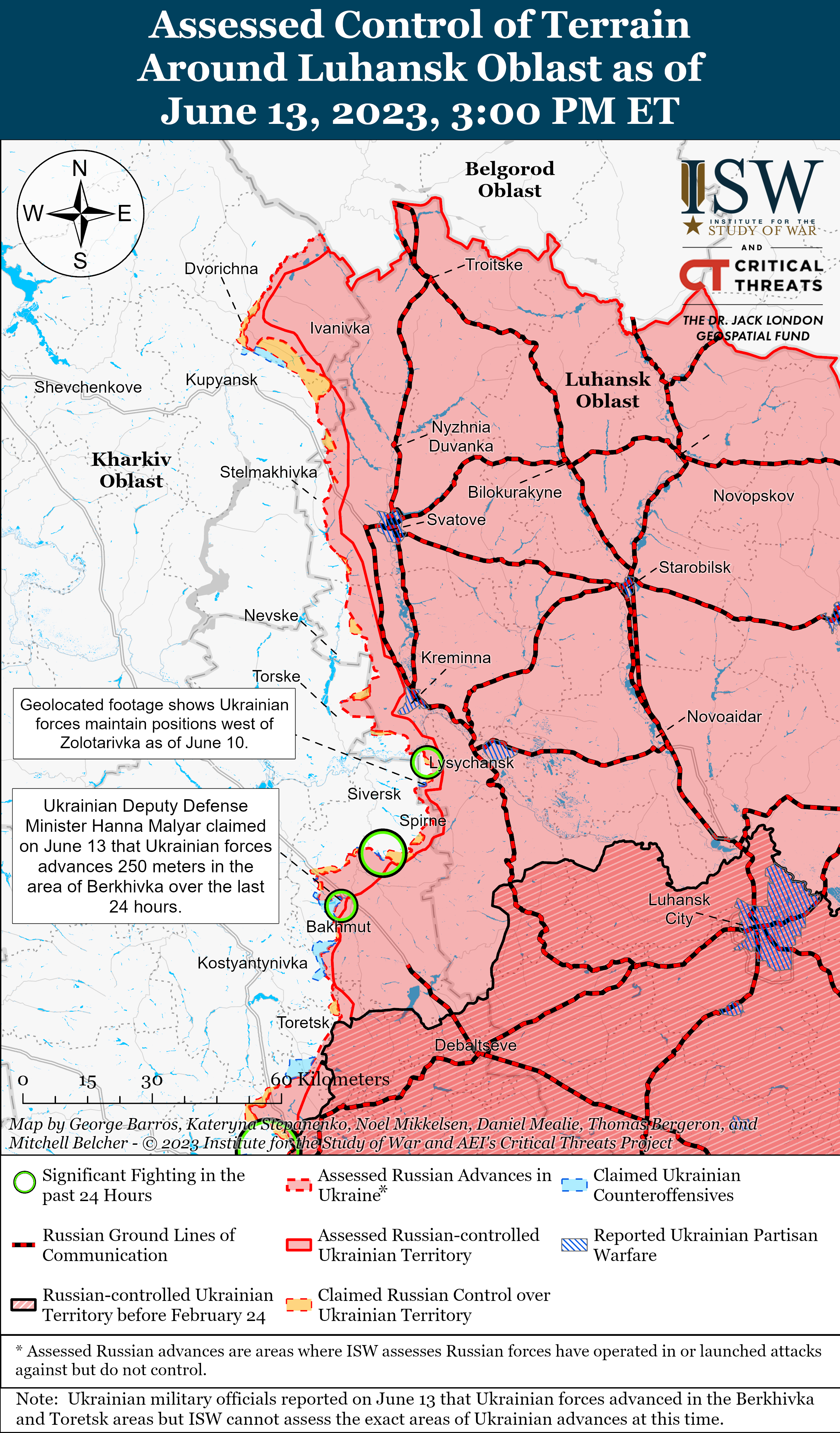
Russian Subordinate Main Effort #2 – Donetsk Oblast (Russian Objective: Capture the entirety of Donetsk Oblast, the claimed territory of Russia’s proxies in Donbas)
Click here to read ISW’s retrospective analysis on the Battle for Bakhmut.
Ukrainian forces continued to advance on Bakhmut’s northern and southern flanks, while Russian forces launched counterattacks in the vicinity of Bakhmut on June 13. Ukrainian Deputy Defense Minister Hanna Malyar reported that Ukrainian forces advanced 250m in the Berkhivka Reservoir area (6km northwest of Bakhmut) and 200m in the Toretsk direction (about 20km southwest of Bakhmut).[37] Malyar added that fighting is ongoing in the Yahidne area (5km north of Bakhmut).[38] The Ukrainian General Staff also reported that Russian forces launched unsuccessful ground attacks in the direction of Orikhovo-Vasylivka (13km northwest of Bakhmut) and Bila Hora (15km southwest of Bakhmut).[39] A Kremlin-affiliated milblogger claimed that Russian forces unsuccessfully counterattacked in the direction of Bila Hora and Ivanivske (6km west of Bakhmut) and claimed that Ukrainian forces were not successful in conducting assault operations in the Berkhivka area.[40] Another Kremlin-affiliated milblogger claimed that Ukrainian forces unsuccessfully attempted to break through Russian defenses in Klishchiivka (7km southwest of Bakhmut).[41] Russian sources also indicated that elements of the “Nevsky” volunteer detachment are continuing to operate on Bakhmut’s northern flanks.[42] Ukrainian Eastern Group of Forces Spokesperson Colonel Serhiy Cherevaty stated that Russian forces are continuing to deploy additional elite airborne and infantry forces to Bakhmut.[43]
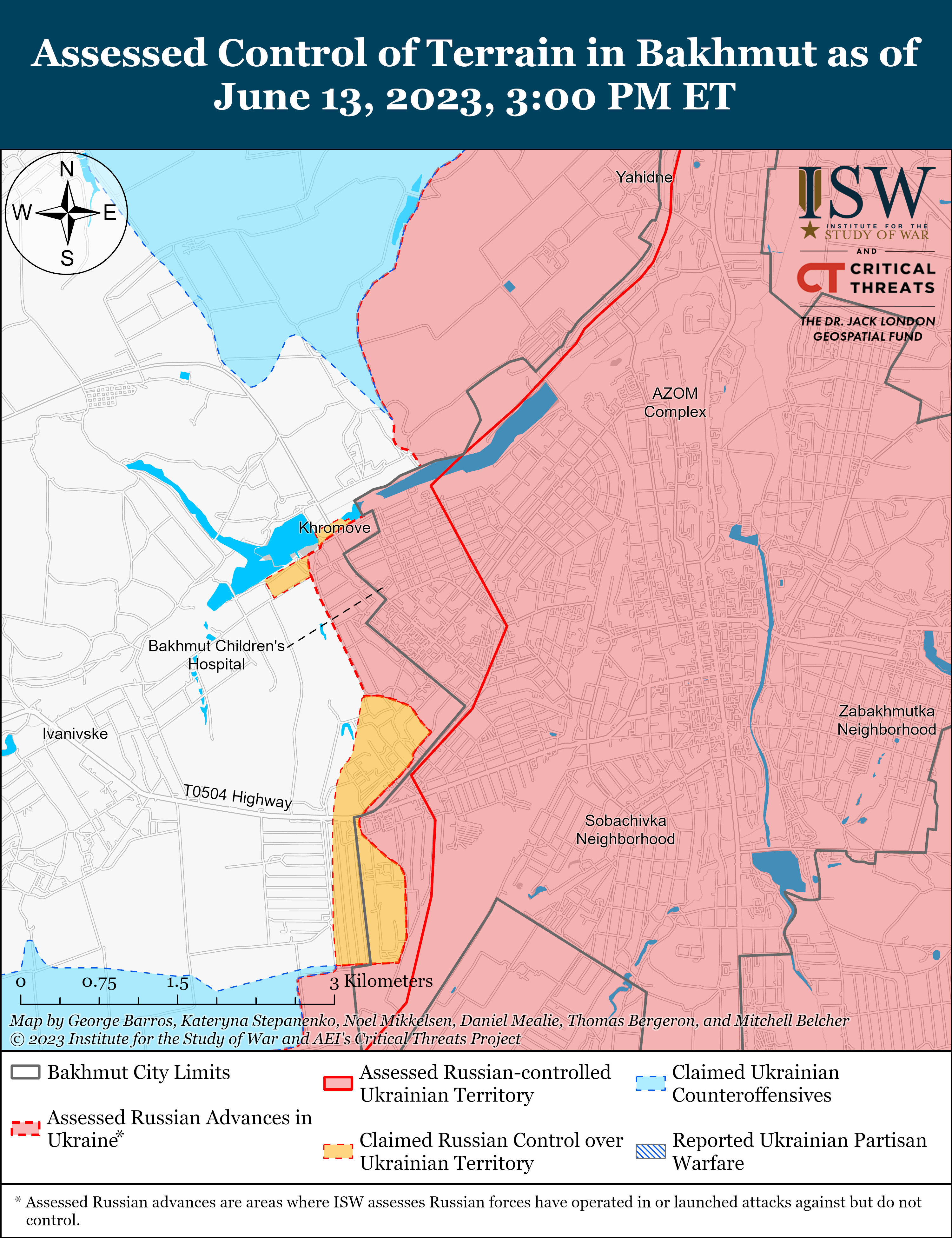
Russian forces continued offensive operations on the Avdiivka-Donetsk City line and are transferring additional forces from east (left) bank Kherson Oblast to reinforce the direction. Ukrainian military officials reported that Ukrainian forces repelled Russian attacks on Avdiivka and Marinka (southwestern outskirts of Donetsk City).[44] Ukrainian Tavriisk Defense Forces Spokesperson Capitan Valeriy Shershen stated that the Russian military command is transferring personnel from Kherson Oblast and noted the arrival of Chechen “South-Akhmat” and “North-Akhmat” units on the Avdiivka-Donetsk City line.[45] Russian sources claimed that Russian forces advanced on the northern and southern approaches to Avdiivka and continued assaults in western Marinka.[46] A Kremlin-affiliated milblogger contrarily claimed that Russian forces attacked on the northwestern approaches to Avdiivka but did not make any territorial gains.[47]
Russian forces did not conduct any confirmed offensive ground operations in the Vuhledar area. A Russian source claimed that elements of the Russian 68th Army Corps of the Eastern Military District are engaged in artillery fire in the vicinity of Vuhledar.[48]
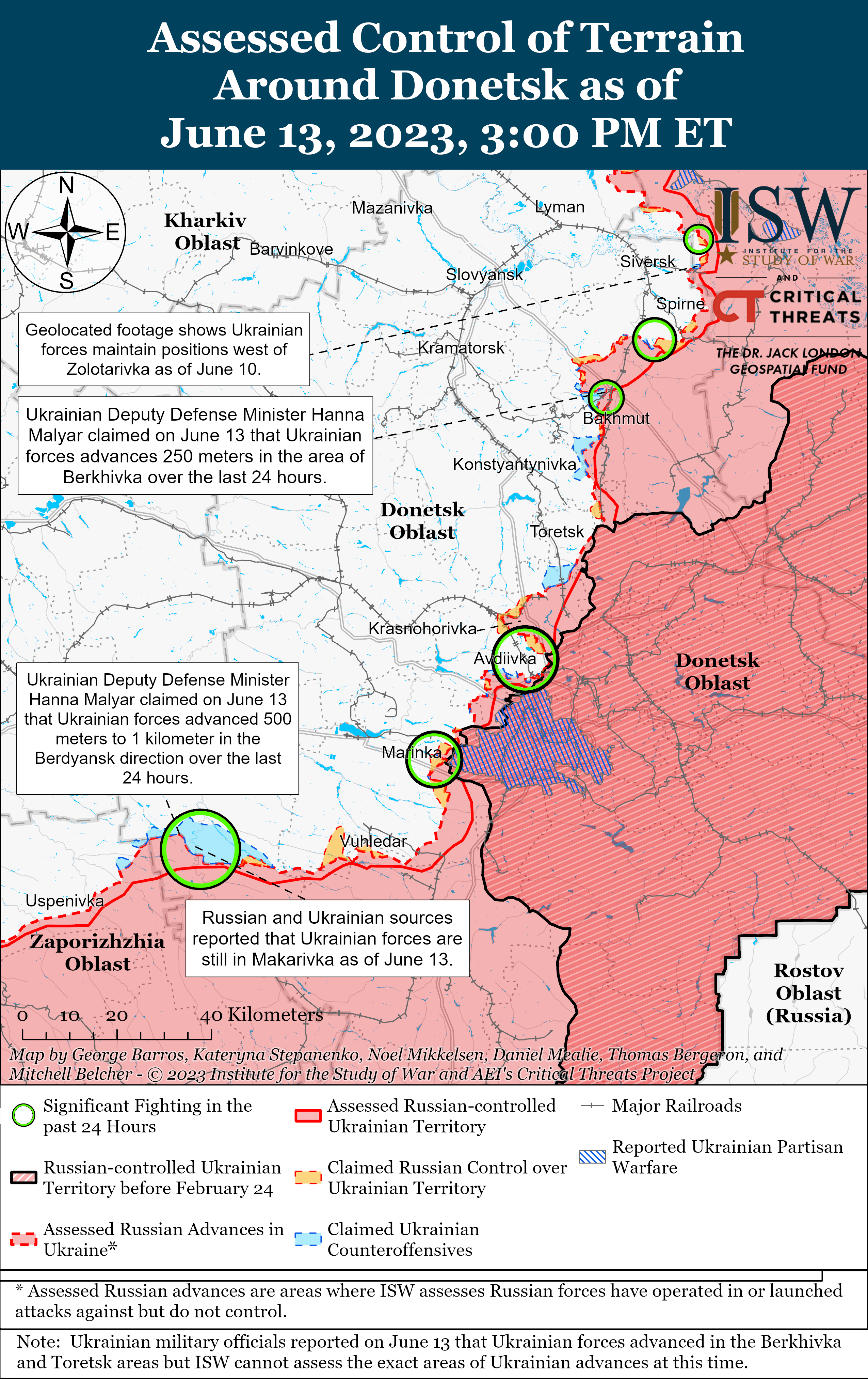
Russian Supporting Effort – Southern Axis (Russian objective: Maintain frontline positions and secure rear areas against Ukrainian strikes)
Russian forces conducted limited ground attacks near the administrative border of Donetsk and Zaporizhia oblasts on June 13. Ukrainian Tavriisk Defense Forces Spokesperson Captain Valeriy Shershen reported that Russian forces continued attempts to recapture Makarivka (7km south of Velyka Novosilka) and conducted unsuccessful operations in the Vremivka salient (immediately west of Velyka Novosilka) and Blahodatne (5km south of Velyka Novosilka) directions.[49] Ukrainian and some Russian sources reported that Ukrainian forces maintained their positions in Makarivka as of June 13.[50] Some Russian milbloggers reported that that Russian and Ukrainian forces continued fighting over the settlement on the night of June 12 to 13 and that the settlement continues to be in a contested ”grey zone.”[51] Russian sources claimed that fighting is ongoing near Staromayorske (7km south of Velyka Novosilka) and Urozhaine (9km south of Velyka Novosilka).[52] The Russian Ministry of Defense (MoD) claimed that Russian forces repelled two Ukrainian attacks near Rivnopil (9km southwest of Velyka Novosilka).[53] Ukrainian Deputy Defense Minister Hanna Malyar reported on June 13 that Ukrainian forces advanced from 500-1,000 meters and liberated up to 3 square km of territory in the Berdyansk direction over the past 24 hours.[54]
Ukrainian forces conducted ground attacks in western Zaporizhia Oblast on June 13. Russian milbloggers claimed that Ukrainian forces conducted offensive operations near Pyatykhatky (23km southwest of Orikhiv) and Dorozhyanka (34km southeast of Hulyaipole), and that fighting is ongoing south of Orikhiv and near Lobkove (24km southwest of Orikhiv).[55] Russian sources claimed that volunteer formations including the ”Crimea,” ”Storm Ossetia,” ”Alania,” and ”Sarmat” battalions are operating in Zaporizhia Oblast.[56] Russian sources reported that elements of 58th Combined Arms Army (Southern Military District) including the 291st Motorized Rifle Regiment and 72nd Motorized Rifle Regiment (42nd Motorized Rifle Division) and the 429th Motorized Rifle Regiment (19th Motorized Rifle Division) continue to operate in Zaporizhia Oblast.[57]
Russian President Vladimir Putin claimed that Russian forces did not observe large explosions at the Kakhovka Hydroelectric Power Plant (KHPP) dam on June 5.[58] Putin claimed that Ukrainian forces previously struck the dam in repeated HIMARS strikes and that it is possible that some “insignificant” Ukrainian strike that Russian forces did not notice caused the destruction. Putin asserted that Ukrainian forces intentionally destroyed the dam, although the extent of the damage at the dam could not have been achieved with a HIMARS rocket let alone munitions that would have created such a small explosion that Russian forces did not notice it. ISW previously reported that several independent sources reported that an internal explosion likely destroyed the KHPP dam.[59] ISW assesses that the balance of evidence, reasoning, and rhetoric suggests that Russian forces deliberately damaged the KHPP dam.[60]
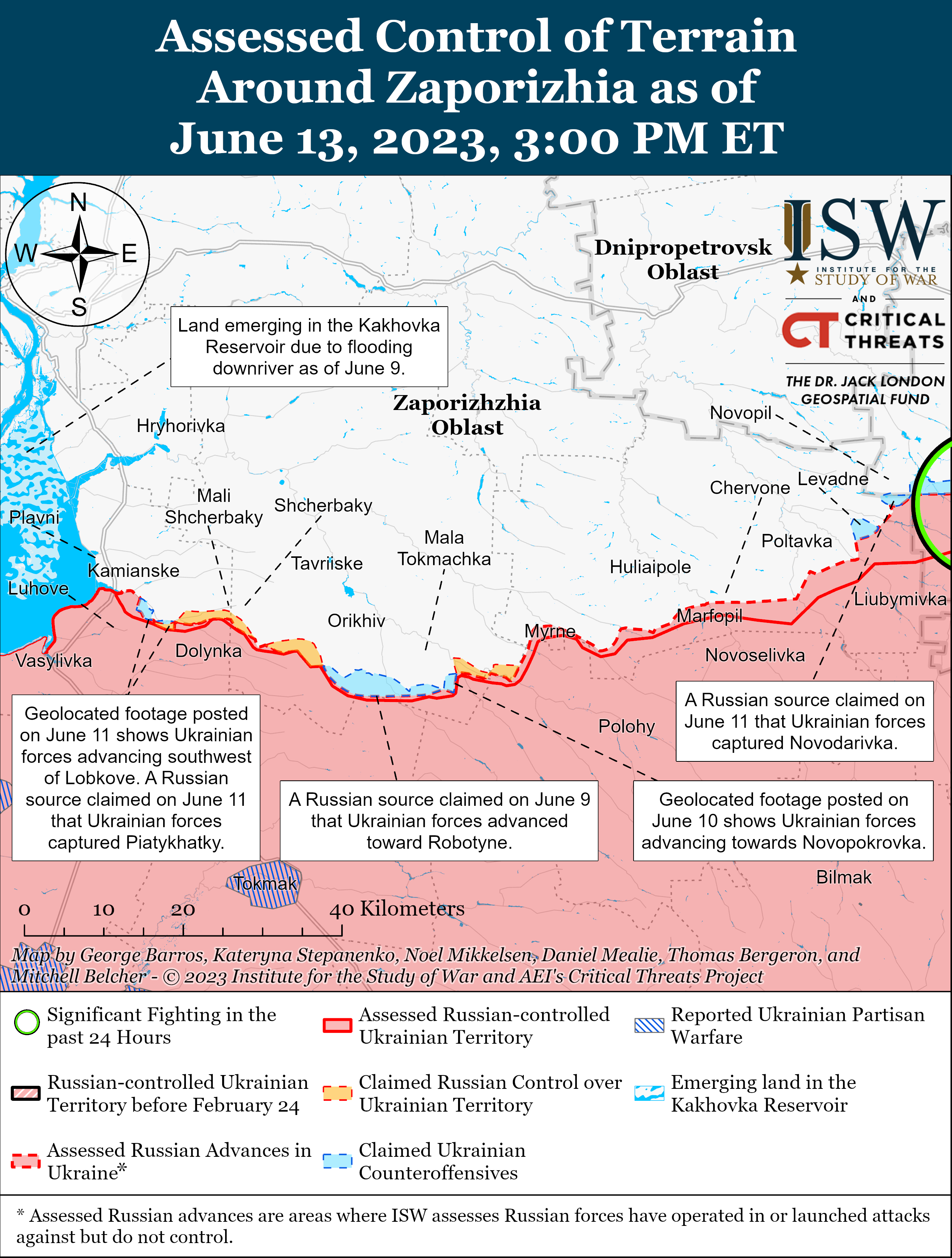
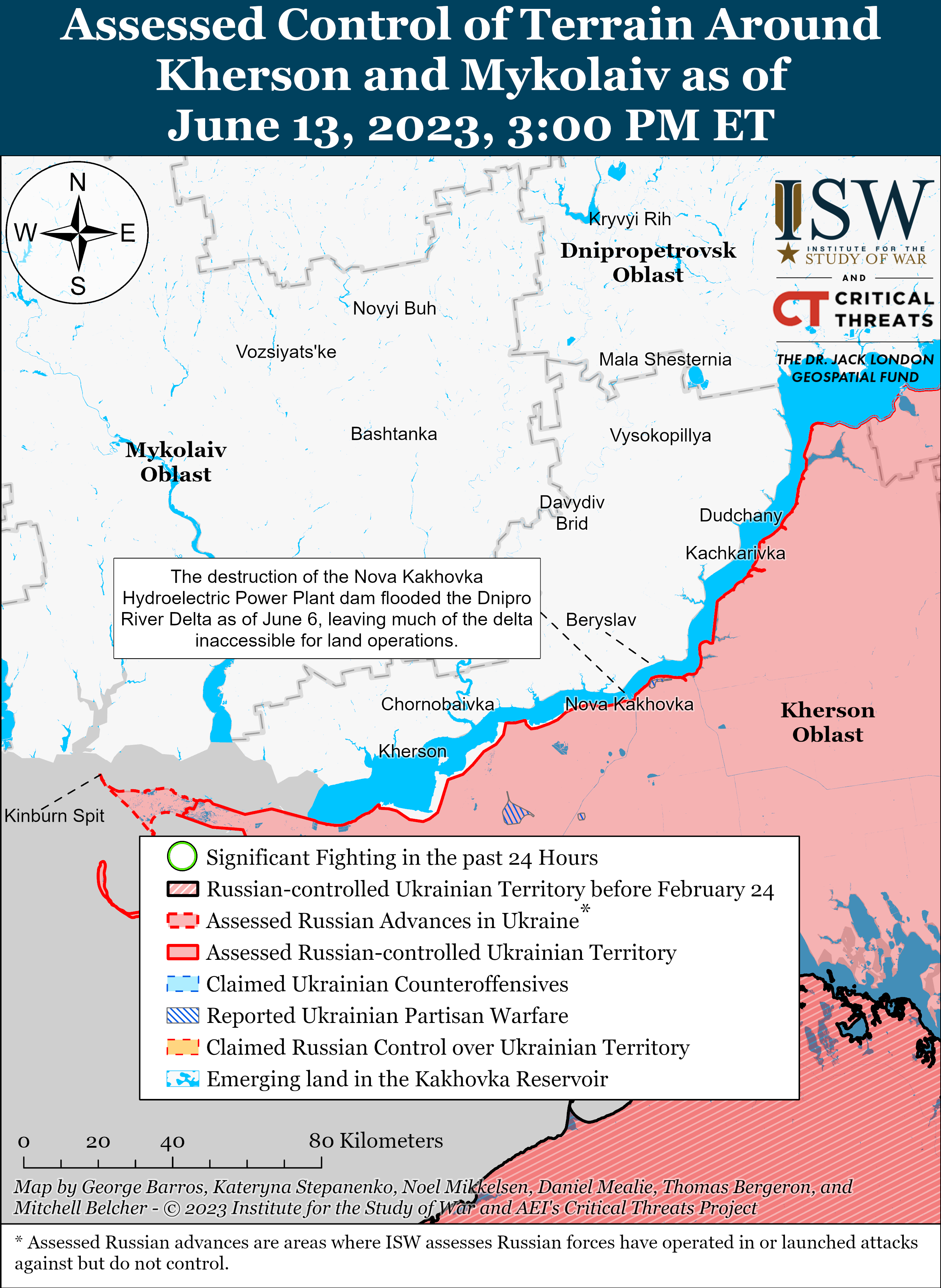
Russian Mobilization and Force Generation Efforts (Russian objective: Expand combat power without conducting general mobilization)
Russian President Vladimir Putin claimed that the Russian military has recruited 150,000 contract servicemembers as well as over 6,000 volunteers since January 2023.[61] Russian Security Council Deputy Chairman Dmitry Medvedev previously claimed on May 19, 2023, that the Russian military has recruited 117,400 contract personnel into volunteer formations since January 1, 2023.[62] It is unclear if Putin misreported the number of contract servicemen with the total number of Russian personnel who have signed contracts with the Ministry of Defense (MoD) since January or if Medvedev previously misreported the number of those recruited into volunteer formations.
The Russian MoD continues efforts to formalize volunteer formations. The MoD claimed on June 13 that three volunteer brigades and four separate volunteer detachments signed contracts with the MoD as part of Russian Defense Minister Sergei Shoigu’s order for all Russia volunteer personnel to sign contracts directly with the MoD by July 1.[63] ISW assesses that the MoD’s ongoing formalization efforts aim to centralize control over Russian irregular personnel and supplies to respond to Ukrainian counteroffensive operations while also restricting the influence of figures outside of the MoD, primarily Wagner Group financier Yevgeny Prigozhin.[64]
Putin confirmed that he is signing decrees to pardon convict recruits serving with Russian forces in Ukraine.[65] Putin ludicrously claimed that convict recruits have a recidivism rate of 0.4 percent as compared to the regular recidivism rate of 40 percent.[66] Kremlin Spokesperson Dmitry Peskov previously stated that Putin has been issuing preemptive pardons for convicts who serve in Russian operations in Ukraine.[67] ISW has previously assessed that preemptive presidential pardons may be driving further recruitment within Russian penal colonies.[68]
Putin signed a law on June 13 permitting Russian authorities to seize the passports of Russian citizens who receive summonses for military service.[69] The State Duma adopted the law in May 2023 and the Federation Council approved it on June 7.[70] The Kremlin previously passed legislation that would allow Russian officials to prevent those who receive military summonses from leaving the country within 20 days of being summoned to crack down on Russian draft dodgers.[71] The new law likely aims to further expand Russian authorities’ ability to prevent Russian citizens from fleeing military service.
Russian officials proposed a draft bill on June 13 that would set conditions to exempt individuals who have signed a contract for military service from criminal liabilities. Russian Senator Andrey Klishas and State Duma deputies Pavel Krasheninnikov and Irina Pankina proposed the bill to exempt mobilized and contract Russian servicemembers from liabilities of crimes of a “small and medium gravity.”[72] The proposed bill does not specify what crimes constitute as being of a ”small and medium gravity” and the bill would reportedly apply to the entirety of a contract period including during partial mobilization, martial law, or war.[73] The measures may be an effort to shield Russian servicemembers from punishments stipulated by Russian law for crimes they commit in occupied territories in Ukraine.
Prigozhin visited the Muromteplovoz factory in Murom, Vladimir Oblast on June 13, likely in an effort to expand Wagner Group’s access to supplies and equipment.[74] The Muromteplovoz factory produces armored personnel carriers, armored fighting vehicles, and infantry fighting vehicles.[75]
A Russian commander reportedly complained that the Russian military does not give smaller supply vehicles to units in advanced positions on the frontline. A Russian milblogger amplified a critique from a Russian commander in which the commander argued that the delivery of supplies and goods to the front is fraught with equipment losses and that smaller vehicles would be harder for Ukrainian forces to detect.[76] The milblogger claimed that individual units purchase these smaller vehicles as well as night vision devices for the vehicles at their own expense or with the help of volunteers.[77]
Activities in Russian-occupied areas (Russian objective: Consolidate administrative control of annexed areas; forcibly integrate Ukrainian civilians into Russian sociocultural, economic, military, and governance systems)
Russian occupation officials in east (left) bank Kherson Oblast are reportedly continuing evacuation efforts, although are likely continuing to deny services to some residents in flooded areas. Kherson Oblast occupation administration head Vladimir Saldo claimed that Russian occupation officials have evacuated 7,200 residents from flooded areas in left bank Kherson Oblast as of June 13 and that 1,700 residents are staying at temporary accommodation centers.[78] The Ukrainian Resistance Center reported that Russian forces have prevented hundreds of people from leaving flooded areas in left bank Kherson Oblast, particularly in Oleshky Hromada.[79] Advisor to the Kherson Oblast Military Administration Head Serhiy Khlan reported that Russian occupation officials did not conduct evacuations in Nova Kakhovka and have instead massively looted the flooded settlement.[80]
Russian officials are reportedly trying to streamline checkpoints between occupied Kherson Oblast and Crimea. The Kherson Oblast Occupation Administration reported on June 12 that Russian Deputy Prime Minister Marat Khusnullin visited the Chonhar checkpoint in Kherson Oblast on the border with Crimea and set deadlines for its reorganization.[81] Khusnullin reportedly set the deadlines in accordance with Russian President Vladimir Putin’s instructions to modernize checkpoints between occupied territories and Russian-occupied Crimea as well as Russia itself.[82] Russian officials are likely trying to lift stringent security measures and expand facilities at checkpoints to diminish delays along important ground lines of communication (GLOC) and better supply the Russian grouping in southern Ukraine.
Significant activity in Belarus (Russian efforts to increase its military presence in Belarus and further integrate Belarus into Russian-favorable frameworks).
ISW will continue to report daily observed Russian and Belarusian military activity in Belarus, as part of ongoing Kremlin efforts to increase their control over Belarus and other Russian actions in Belarus.
The Belarusian Ministry of Defense announced that the Belarusian military’s logistics head will conduct a command-staff exercise on command and control for logistics support on June 13-16.[83] ISW previously assessed that similar Belarusian logistics exercises can support a permanent Russian military presence in Belarus.[84]
Note: ISW does not receive any classified material from any source, uses only publicly available information, and draws extensively on Russian, Ukrainian, and Western reporting and social media as well as commercially available satellite imagery and other geospatial data as the basis for these reports. References to all sources used are provided in the endnotes of each update.
View Citations